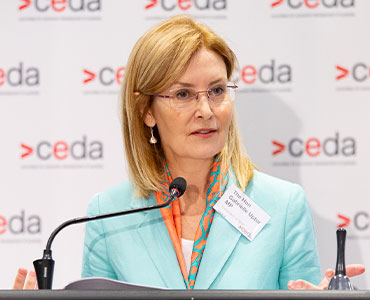The biggest challenge with research and development (R&D) is the translation and application of it, NSW Government Parliamentary Secretary to the Premier, the Hon. Gabrielle Upton, told a CEDA audience in Sydney.
 Ms Upton, who appointed the NSW Government’s Accelerating R&D Advisory Council, said that four key levers had emerged from over 100 written submissions and dozens of stakeholder meetings during the Council’s public consultations which finished in mid-December.
Ms Upton, who appointed the NSW Government’s Accelerating R&D Advisory Council, said that four key levers had emerged from over 100 written submissions and dozens of stakeholder meetings during the Council’s public consultations which finished in mid-December.
“The first lever is government action, how we use our role as a government as a participant in the R&D ecosystem,” she said.
“A strong theme in the submissions we received is that we need to be more strategic as a government, whether that’s being a champion to drive R&D and commercialisation, or clarifying and in fact better communicating our priorities, so that you know where we’re going and what we want to do.
“Our government needs a front door for R&D. I’ve had stakeholders tell me they’re not sure exactly where to go inside our large government when they want to discuss R&D and translational opportunities.
“We don’t want to lose those great opportunities simply through bad way-finding in government.”
Ms Upton said the second lever is around attraction – how to attract and retain the best talent, and the best investment to NSW.
“And on that front I’m pleased to say we are already doing work, there is a better targeted and coordinated international investment strategy that was launched by the Premier called the Global NSW Strategy. That was in December of last year,” she said.
“Another important step is to ensure that when we sponsor companies, when we bring them here, that they also undertake a proportion of R&D investment and function here in NSW, they don’t just bring their marketing and sales activities.
“There’s nothing wrong with marketing and sales but we should actually say: we want a proportion of your R&D spend here, you can’t leave that in LA, you can’t leave that in London, you have to bring that with you.”
The third lever identified by the Advisory Council was collaboration.
“How do we bring our stakeholders together in a way to leverage our respective insights and strengths,” she said.
“I’ve heard very strong support for our innovation precincts. They bring the whole of the innovation ecosystem into one place so that people can more easily make those connections, test their ideas, get access to infrastructure and pitch to finance at the point when they need it.
“And when I speak with venture capitalists they sum that up by saying precincts reduce friction and increase collisions, which is a great way to think about it.”
“And the fourth lever, translation – how does NSW support the start-ups to scale up and commercialise their research.
“We need leadership, we need more collaboration and we need more coordination,” she said.
“We’ve got to identify our industry research priorities and then we can better create the pathways to support those priorities at the time where they need us, where there’s market failure or where no one else can step in and do that work.
“We’ve got to better communicate those priorities so that you can align your efforts with us. We have a major role in creating the space, the places and the infrastructure for innovation to thrive.”
NSW Chief Scientist and Engineer and NSW Accelerating R&D Advisory Council Member, Professor Hugh Durrant-Whyte said precincts are the key to progressing R&D.
“The precincts around the world that really work are ones that genuinely have a focus; digital, bio etc. that genuinely attract people,” Professor Durrant-Whyte said.
“And there’s sort of a gravity effect of ‘there’s lots of people who are good in this area here, therefore I will move there’ and you really need to accelerate that.
“In Sydney we already have that, and its really good. Medical devices would be one example, but the digital side of what’s going on in places like York Street, it’s great.
“And when you see it, and it works, start heating it up by supporting it, asking what’s needed, make it happen.
“Don’t get in the way is perhaps a lesson from Ronald Reagan around government engagement in these things.”
NSW Accelerating R&D Advisory Council Chair, David Gonski AC, also spoke at the event and likened innovation precincts to a coliseum.
“It’s the place where people can come, and I think we need the precincts to happen to see these endeavours being raised and spoken about,” he said.
“Everybody needs R&D, whether we’re in the services industry, whether we’re in mining and we have those abilities inherent in Australia and very much in this state.
“And I think what Gabrielle has charged us with is to take these inhibitors and benefits within the state, turn them into advantage so that we are the state that can produce this and so we can bat above our average.”
Published 27 February 2020